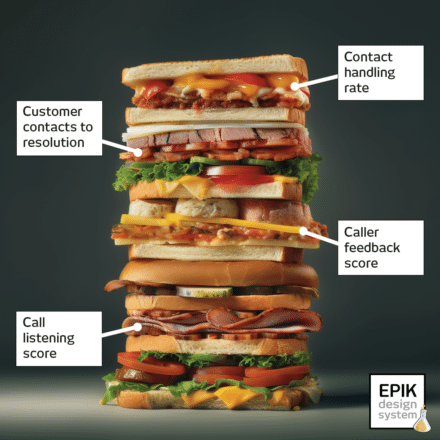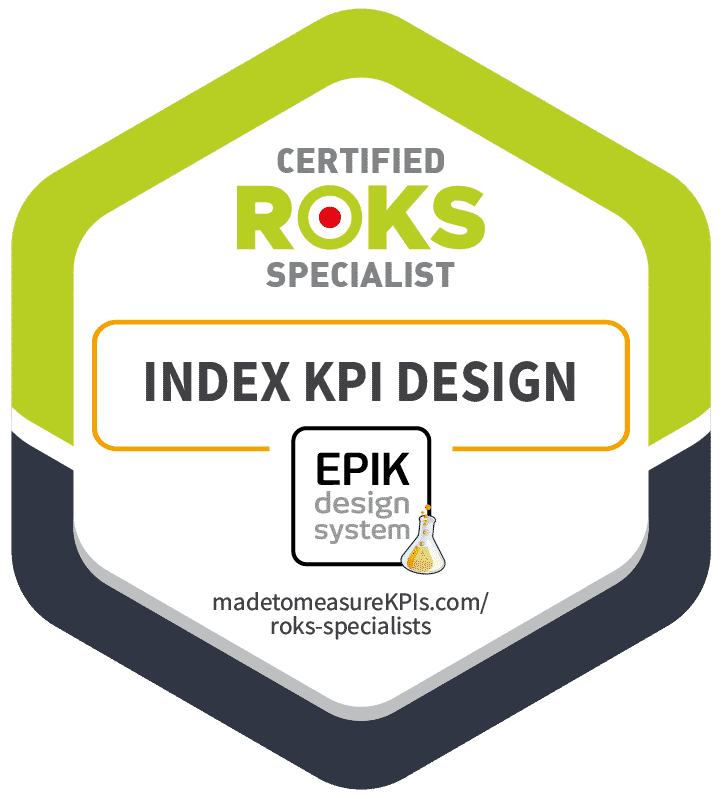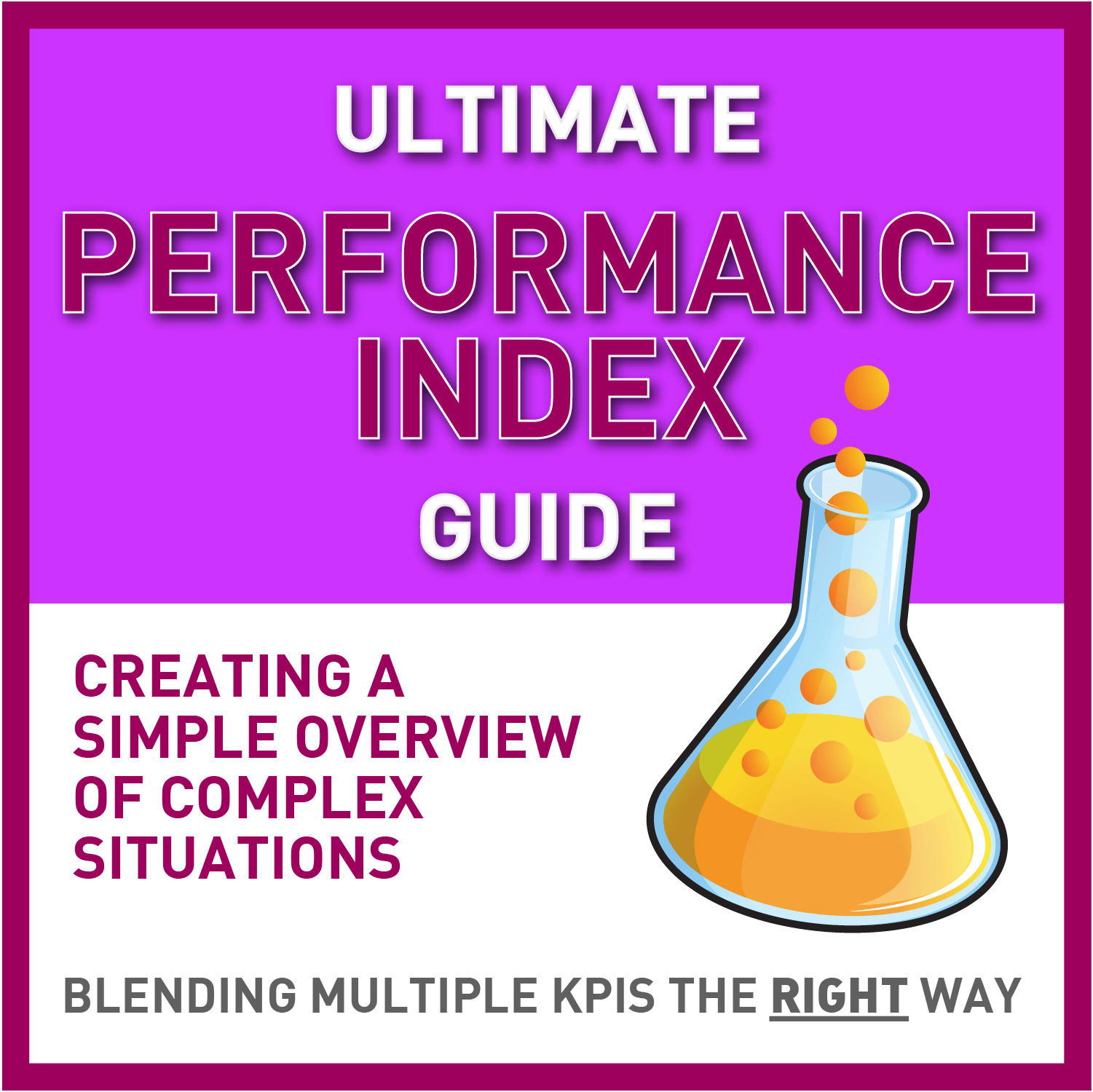
What is the difference between a Key Performance Indicator and a Key Performance Index?
A Key Performance Indicator (KPI) is a singular measure used to quantify the performance of an individual, team, or organisation.
A Key Performance Index is an aggregate metric that combines multiple measures (Key Performance Indicators) into a single overview.
Key Performance Indexes are a great way to measure progress towards strategic goals in complex situations, quickly and easily.
Check out our Ultimate Guide to Brilliant Index KPIs for an in-depth definition.
What is the difference between a composite KPI and a performance index?
There is no difference between these two metrics. Composite KPI and performance index (or index KPI) are two different names for the same type of metric.
What are some Key Performance Index examples?
Here are some index KPI examples you have probably stumbled across without even noticing that they are index KPIs:
-
- BMI - Body mass index. An indication of "lean-ness" in a single number
- FTSE 100 - A stock exchange index showing how the UK stock market is performing
- Credit score - using past credit behaviour to assess capacity and willingness to pay back lending
- Activity "scores" used by fitness monitoring gadgets like the Apple watch
Check out our Ultimate Guide to Brilliant Index KPIs for more examples!
Why use index KPIs (Key Performance Indexes)?
Index KPIs are a powerful, underused way of combining multiple indicators into a single at-at-glance indicator. They are perfect for complex situations where rapid understanding and action are needed.
What are the best situations to use an index KPI?
The best situations to use an index KPI are when you want to...
-
- Summarise complex situations with a single number.
- Free up much-needed dashboard space without compromising on the mix of input data.
- Be driven to think about how measurement entities interact (e.g., downtime, quality, and rate in the case of OEE - Overall Equipment Effectiveness).
By their very nature, index KPIs require more design and thought than other types of KPIs, but the benefits can be well worth the effort.
When should you not use index KPIs?
Performance indexes are blunt instruments. The exact scores vary depending on how they are designed, so you can't solely rely on them for 'big' decisions, especially when comparing minor differences between index scores.
They are good for 'at a glance' assessments, driving behaviour in the right direction, and trend analysis. But they can also be poorly designed, incorrectly weighted or unrepresentative. If you have any doubts about how an index works, you need to pull it apart, understand how it works and do some deeper analysis before using it to inform decision-making.
Situations where an index is a bad idea include:
-
- The audience is a non-technical (or unsophisticated) crowd, so they may not be able to figure out how the index KPI works.
- There is little evidence of a link between the various components of the index KPI/indicators.
- The new index has not been properly explained to the target audience, or they don't trust it.
In short: don't blindly rely on performance indexes - use them as one piece of a larger puzzle. Consider other factors alongside them to get a fuller picture before making any decisions.
How many metrics should I use in my Index KPIs?
The number of metrics you use in your Index KPI should be based on the complexity of what you're measuring.
For example, if you're trying to measure healthy body weight, you might use a Body Mass Index (BMI), which combines just two metrics: Height and body weight
To measure the performance of a veterinary doctor, you may want to combine multiple different tracking KPIs, including:
-
- Mortality/morbidity rate
- Utilisation (doctor) - fill rate
- Invoice discount %
- Customer referrals by existing customers
- New complaints
- Re-admission rates
You can combine as many KPIs as you want into an index, twenty or even thirty ingredient metrics, but you have to be extremely careful how you design the index when you have this many components. More KPIs increase the chance of an unexpected result in certain situations. For an index KPI of that complexity, it is essential to use a structured approach like the EPIK Design System.
How do you mix 'more is good' with 'more is bad' metrics?
Some measures are good when they have a 'high' value - think customer satisfaction, profit, or sales. Other KPIs can be a disaster when they increase, think complaints, regretted staff attrition, or late deliveries.
A number of methods can be used to combine these different kinds of KPIs, but they all boil down to 'reversing the polarity' of some of the ingredient measures. Put simply, be clear whether 'more is good' or 'more is bad' for the overall index KPI, then invert any ingredient KPIs that don't conform with this decision.
Should Key Performance Indexes have a maximum?
There are two types of index, ranged (e.g, Toyota Prius Eco score, out of 100) and open-ended (e.g., S&P 500, which has no upper limit). An index KPI can be either type, it's a case of choosing which makes sense for your particular situation.
Is it OK to mix leading and lagging indicators?
Lagging performance indicators are measures that tell you how you did, so are backward looking. Profit is a commonly used, important, lagging performance indictor. Leading indicators tell you how things will likely perform in the future, so give you a chance to take action before things happen. Customer satisfaction would be a leading indicator for repeat sales.
The most important thing with index KPIs is that they make sense. So if it makes sense to combine leading and lagging indicators then go ahead. For example a sales index might include both sale performance (lagging) and the sales funnel health (leading).


What is the best way to design a Key Performance Index?
- Use a structured method. Check out the EPIK Design System for a complete 7-step method to build effective index KPIs.
- Be organised and keep careful notes on assumptions and logic used to design the index.
- Test and refine the index design. Then test again.
- Make sure you fully involve the index stakeholders in the development process.
Do you have any tips for designing index KPIs?
There are a few things to keep in mind when designing index KPIs:
-
- Keep the goal in mind.
- Don't overcomplicate things if you can avoid it.
- Test, test, and test again.
- Look at weird and extreme situations and see if it still makes business sense.
- Use a structured method for building them.
- Document everything very carefully.
Don't forget to check out this Ultimate Guide to Brilliant Index KPIs for everything you need to know about key performance indexes.
How do you test an index KPI?
There are a few different ways to test an index KPI. One approach is to look at the extremes of the input data and see how the index responds. What happens when all our inputs are 'good' or 'bad'? Does the result make sense?
Another way to test an index KPI is to look at unusual results mixes. For example, if you have a KPI based on sales volume and customer satisfaction, you would want to see what happens when there is a decrease in sales volume but an increase in customer satisfaction. Does the index KPI result still make sense in this unusual situation?
How can I find out more about how to design index KPIs?
I'm glad you asked! You can find out more about a structured approach in our Ultimate Guide to Brilliant Index KPIs, and you can take your performance index design skills to "boss level" using our online training program and templates pack.
What are the most common problems with key performance indexes?
- Poorly designed indexes can be misleading
- Indexes can hide important information
- Metrics used in an index may not be relevant or related to each other
- Index construction can be complex and time-consuming
Can index KPIs be applied to all levels of an organisation?
Index KPIs can be effectively applied across various levels of an organisation, each tier requiring a tailored approach to ensure the indicators remain relevant and impactful. At the top level, these KPIs provide senior management with a holistic view of organisational performance, crucial for strategic decision-making. Moving to the mid-tier, index KPIs help align departmental objectives with broader goals, offering managers insight into specific areas like team productivity or project progress.
At the operational level, these KPIs become more granular yet retain their composite nature, aiding in the evaluation of day-to-day activities. However, it's essential for these KPIs to be aligned with strategic objectives and be understandable at each level. The complexity of performance indexes should match the decision-making scope they are intended to inform, ensuring clarity and effectiveness across the organisation.
Index KPIs can be powerful tools for any business. Following the tips in this blog and our Ultimate Guide to Brilliant Index KPIs should help you design performance indexes that keep your focus on improving your business, not on reading huge reports. It's a big topic so if you have more questions, don't hesitate to get in touch!
Learn how to build your own Index KPIs with Excel








